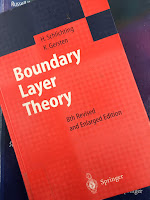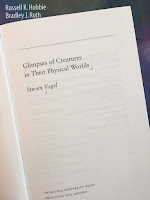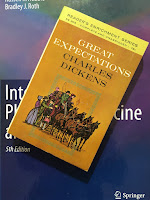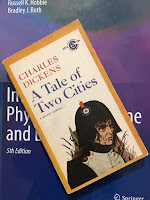For a Newtonian fluid … with viscosity η, one can show (although it requires some detailed calculation6) that the drag force on a spherical particle of radius a is given byFootnote 6 says “This is an approximate equation. See Barr (1931, p. 171).”
Fdrag = − β v = − 6 π η a v.
This equation is valid when the sphere is so large that there are many collisions of fluid molecules with it and when the velocity is low enough so that there is no turbulence. The result is called Stokes’ law.
We can derive the form of Stokes’s law from dimensional reasoning. For a spherical particle of radius a in a fluid moving with speed v and having viscosity η, try to create a quantity having dimensions of force from some combination of a (meter), v (meter/second), and η (Newton second/meter2; see Sec. 1.14). The only way to do this is the combination η a v. You get the form of Stokes’ law, except for the dimensionless factor of 6π. Calculating the 6π was Stokes’ great accomplishment.
 |
| Boundary Layer Theory, by Schlichting and Gersten. |
The oldest known solution for a creeping motion was given by G. G. Stokes who investigated the case of parallel flow past a sphere [17]. The solution of eqns. (6.3) [Navier-Stokes equation] and (6.4) [div v = 0] for the case of a sphere of radius R, the centre of which coincides with the origin, and which is placed in a parallel stream of uniform velocity U∞, Fig. 6.1, along the x-axis can be represented by the following equations for the pressure and velocity components [Eqs. 6.7, which are slightly too complicated to reproduce in this blog, but which involve no special functions or other higher mathematics]. . . The pressure distribution along a meridian of the sphere as well as along the axis of abscissae, x, is shown in Fig. 6.1 [a plot with a peak positive pressure at the upstream edge and a peak negative pressure at the downstream edge]. The shearing-stress distribution over the sphere can also be calculated from the above formula. It is found that the shearing stress has its largest value [at a point along the equator in the sphere center] . . . Integrating the pressure distribution and the shearing stress over the surface of the sphere we obtain the total drag D = 6 π μ R U∞ This is the very well known Stokes equation for the drag of a sphere. It can be shown that one third of the drag is due to the pressure distribution and that the remaining two thirds are due to the existence of shear. . . the sphere drags with it a very wide layer of fluid which extends over about one diameter on both sides.Reference 17 is to Stokes, G. G. (1851) “On the Effect of Internal Friction of Fluids on the Motion of Pendulums,” Transactions of the Cambridge Philosophical Society, Volume 9, Pages 8–106.
Schlichting goes on to analyze the flow around a sphere for high Reynolds number, which is particularly fascinating because in that case viscosity is negligible everywhere except near the sphere surface where the no-slip boundary condition holds. This results in a thin boundary layer forming at the sphere surface. In his introduction, Schlichting writes
In a paper on “Fluid Motion with Very Small Friction,” read before the Mathematical Congress in Heidelberg in 1904, L. Prandtl showed how it was possible to analyze viscous flows precisely in cases which had great practical importance. With the aid of theoretical considerations and several simple experiments, he proved that the flow about a solid body can be divided into two regions: a very thin layer in the neighbourhood of the body (boundary layer) where friction plays an essential part, and the remaining region outside this layer, where friction may be neglected.The book that Russ and I cite in footnote 6 is A Monograph of Viscometry by Guy Barr (Oxford University Press, 1931). I obtained a yellowing and brittle copy of this book through interlibrary loan. It doesn’t describe the derivation of Stokes law in as much detail as Schlichting, but it does consider many corrections to the law, including Oseen’s correction (a first order correction when expanding the drag force in powers of the Reynold’s number), corrections for the effects of walls, consideration of the ends of tubes, and even the mutual effect of two spheres interacting. I found the following sentence, discussing cylinders as opposed to spheres, to be particularly interesting: “Stoke’s approximation leads to a curious paradox when his system of equations is applied to the movement of an infinite cylinder in an infinite medium, the only stable condition being that in which the whole of the fluid, even at infinity, moves with the same velocity as the cylinder.” You can’t derive a Stokes’ law in two dimensions.
While boundary layer theory and high Reynolds number flow is important for many engineering applications, much of biology takes place at low Reynolds number where Stokes’ law applies. (For more about life at low Reynolds number, see “Life at Low Reynolds Number” by Edward Purcell.)
 |
| Asimov's Biographical Encyclopedia of Science and Technology, by Isaac Asimov. |
Stokes, Sir George Gabriel
British mathematician and physicist
Born: Skreen, Sligo, Ireland, August 13, 1819
Died: Cambridge, England, February 1, 1903
Stokes was the youngest child of a clergyman. He graduated from Cambridge in 1841 at the head of his class in mathematics and his early promise was not belied. In 1849 he was appointed Lucasian professor of mathematics at Cambridge; in 1854, secretary of the Royal Society; and in 1885, president of the Royal Society. No one had held all three offices since Isaac Newton a century and a half before. Stokes’s vision is indicated by the fact that he was one of the first scientists to see the value of Joule’s work.
Between 1845 and 1850 Stokes worked on the theory of viscous fluids. He deduced an equation (Stokes’s law) that could be applied to the motion of a small sphere falling through a viscous medium to give its velocity under the influence of a given force, such as gravity. This equation could be used to explain the manner in which clouds float in air and waves subside in water. It could also be used in practical problems involving the resistance of water to ships moving through it. In fact such is the interconnectedness of science that six decades after Stokes’s law was announced, it was used for a purpose he could never have foreseen—to help determine the electric charge on a single electron in a famous experiment by Millikan. . .











